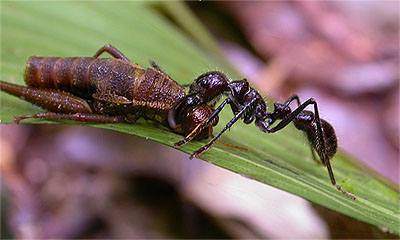
Nutrition
Bullet Ants are generalized as predator-scavengers and have been known to have very voracious appetites. The worker ants within the colonies of P. clavata forage for food in the canopy and understory of the rainforest trees, and very rarely on the ground (Fewell, 1996). The trees associated with the nests of the ants, are used to reach the canopy within the trees. Pheromone trails are used, as well as other landmarks, as a foraging technique for these worker ants. The ants feed on a wide variety of insects ranging from arthropods, other invertebrates, and occasionally pieces of smaller vertebrates. The forager ants that collect the food, are highly attracted to termites which have developed into a main food staple in the diet of P. clavata. Extra-floral nectar, along with water, is also collected and fed to the larvae within the colony. Many of the small food items that are foraged, are carried back to the colony in whole pieces, while the larger ones are first cut into smaller pieces then shared among the other ants within the nest (Zmuida, 2010). An adaptation that the ant has is a compartment within its mouth called the infrabuccal chamber which aids in storing food until it is passed on to larvae or other ants. Any plant pieces gathered by the forager ants, are used to frame the spinning larvae, act as a bedding for pupae, and generally line the chamber walls located in the nest. Feedings usually occur within the colonies at night, however, if the weather causes problems with foraging for food throughout the day, the feeding times can vary (Morgan, 2012).
Being a part of the Arthropods, Paraponera clavata possesses an open circulatory system. This allows them to perform rapid movements, however, they have evolved mechanisms within this system in order to deal with its lack of efficiency. The evolved mechanism is a tubular heart, which is a multi-chambered heart that runs down the dorsal surface of insects. This allows for the increased flow of nutrients from the tube heart to various parts of the body and also allows the nutrients to circulate throughout the body rather quickly.
Proceed to the Reproduction page of P. clavata, or return back to the Home page.
